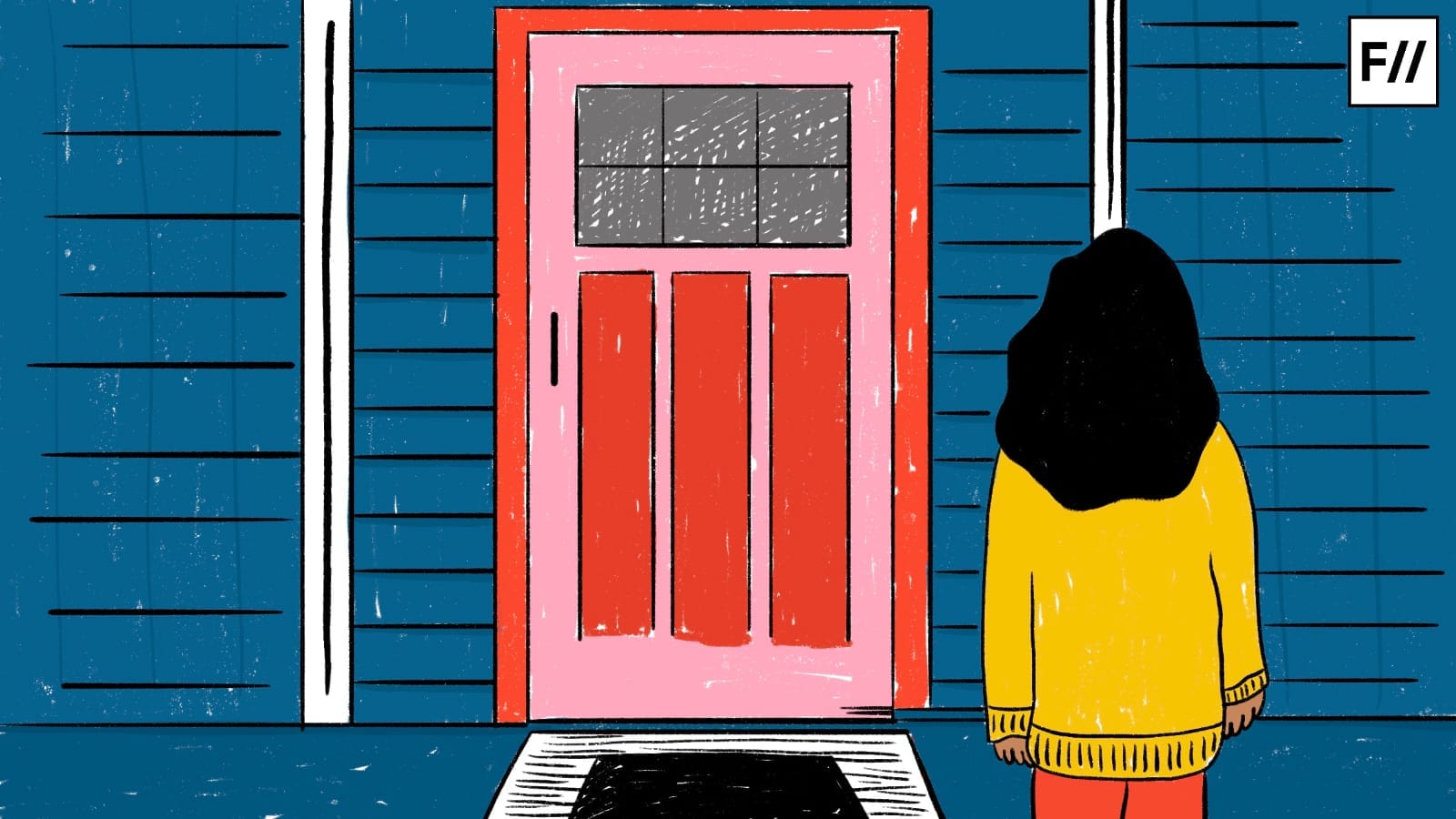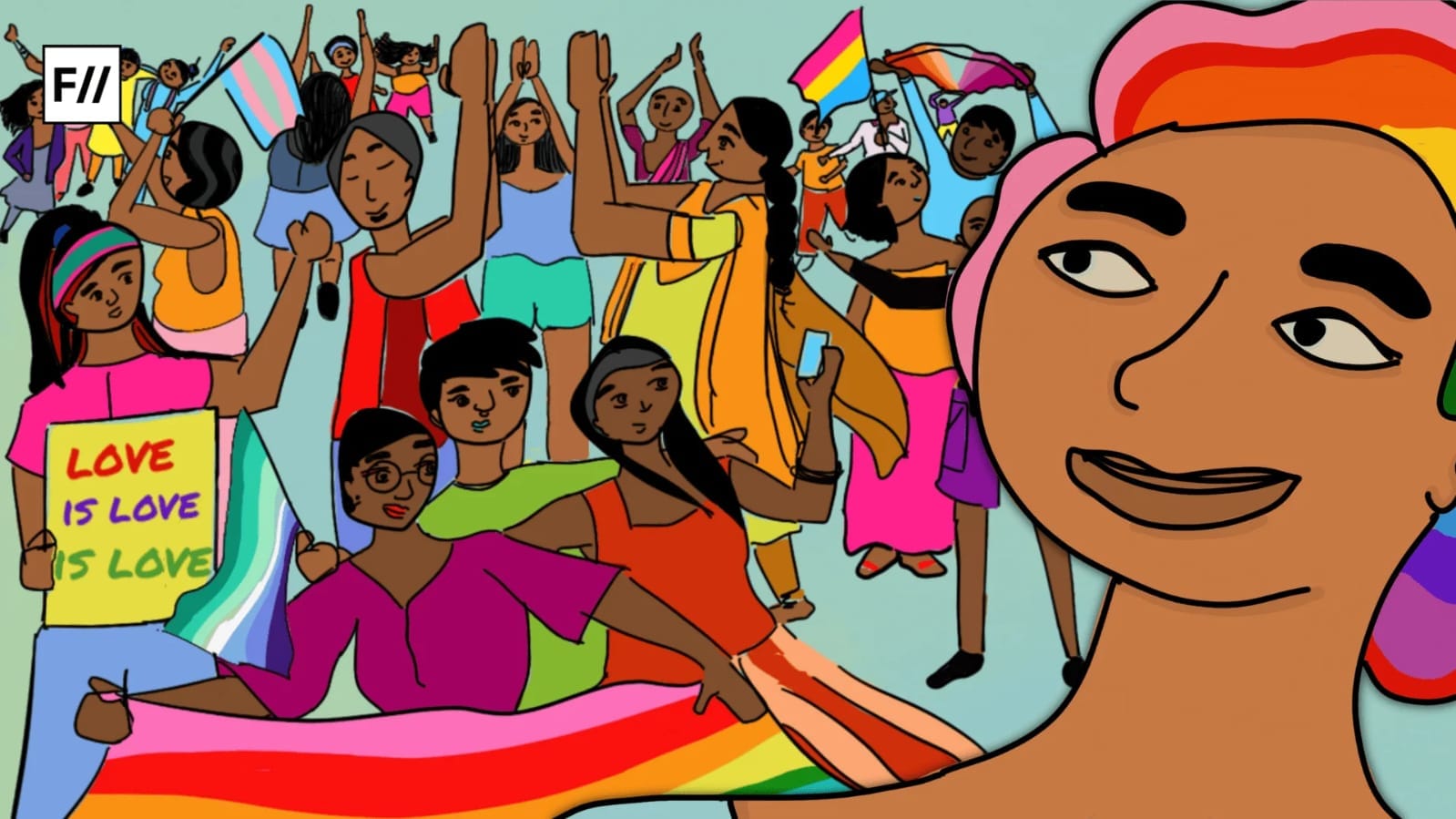Defiant, kinky, and unapologetically ‘Political’. With the politics of intersectionality at its heart, the exhibition ‘Vichitra Desh’ was a spectacular Display of Queer art.
A tale of queer desire and love was woven in the national capital as Delhi pride month kickstarted in early November. An array of beautiful artworks in art forms as diverse as the Queer spectrum was on display at Vichitra Desh – Queer Nation, with artists looking through the windows of marginality. The exhibition dived into feminine desire, queer gaze and kink, unashamedly proclaiming its political aspirations to combat social injustice and climate change, and refusing to shy away from difficult questions of religious orthodoxy, and caste and class privilege.
More than 30 artists from across India and abroad expressed themselves through their artwork with different forms from storytelling to deep fake videos to embroidery. The exhibition was curated by arts and human rights organisation Engendered, with support from the Feminist Studies Department at the University of California. The exhibit was on display from November 2nd to 5th in the cultural hub of Capital, India Habitat Centre.
As the country digests a disappointing Supreme Court judgement that has placed marriage equality out of reach, the Queer movement is gathering force to revitalise and to throw off the smog of despair that has enveloped us just as much as the physical pollution of past months in Delhi.
As the country digests a disappointing Supreme Court judgement that has placed marriage equality out of reach, the Queer movement is gathering force to revitalise and to throw off the smog of despair that has enveloped us just as much as the physical pollution of past months in Delhi. The art event of such magnanimity emphasised upon the action and work that lies ahead for the queer liberation.
The exhibition represented and was created by an intersection of minorities with shared (as well as highly divergent) experiences in a society that is deeply hierarchical. Art has and needs to become a weapon for resistance for these creators who at every stage in their life have had to face the shackles of conformity.
A diversified cast of global artists enlivened by queer feminist post-colonial lenses brought attention to the themes that are fundamental to the countries of Global South. The artists from India, Iran, Brazil, Pakistan, Mauritius, Argentina, & South Africa used a vivid aesthetic framework with nuances in perspectives and richness of their subject matter, all energised by an enchanting queer vision.
The imaginative aesthetics of visual, installation, and performance arts drew heavily from popular culture, epic myth, histories of orientalism, current discourse around climate change, debates over role of religion in modern world. They were lured to touch upon the visual iconographies of the sacred.
The artworks brought into light their daily lived experiences, experiences that are too often sidelined by a state which is increasingly tolerant of vigilantism as well as a socio-religious morality that often tries to discipline sexualities which do not fit an established norm. In a society rooted in socio-cultural conservatism around sex, we need to see more nuanced depictions of love, including marriage and its complicated relation with religion. Religion which often prefers selected narratives while condemning the queer histories (herstories) to inject cis-hetero-patriarchal ideas of family.
History is replete with societal shaming for deviant behaviour, often scrutinised through the texts of religion, law and patriarchy. These condemning structures of societal hierarchy that systematise the punishment for breaking the normative behaviour reflected in different forms of physical, and structural violence. State provided the sanctity to this oppression. Despite the efforts of erasure, vandalism (in case of fire 1996), censure and silencing, art has always broken through these barriers across history. Queer aspirations, love, and passion always found space on margins of history or in taboo art work.
The heteronormative binary that has also been dominating art spaces worldwide (and particularly in India) often makes it difficult for artists to produce and exhibit non-normative works amid shrinking spaces for free speech. This fresh wave of queer art attempts to move beyond just sexuality. Taboo subjects which are often suppressed by family, faith and society with a fervent support from State in policing the lives of artists were all addressed in the exhibit. Not adhering to those norms, the modern queer art sets new definitions against established terms and values. It is not ready to be set into the boxes. These artists neither seek the approval of conservative clergies nor of powerful political actors. Nor the fear of being censored by vigilantes or art gallery curators. Limiting to the confines of norm and tradition has become a thing of past.
One key aspect that emerged from the churnings of this art performance was a more engaging and fluid uses of language and how this open approach has liberated the queer experience. Language always played a central role in maintaining social status quo and was deployed as a tool for repression of sexual minorities as well as other marginal groups.
In a post-modern world, language has become an effective tool in emancipation of these peoples which can be described as a ‘historical anomaly’. It would be vital to see how this expansion of terminology shapes the movement in new directions as the curator Myna Mukherjee put it ‘The point is to look at the liberation of terminologies. Queer has the potential of expanding its meaning from its normative pedagogical references and to re-contextualise it from a intersectional and marginal point-of-view.’
As Vichitra Desh ventured on a journey of exploring the queer ness, this distinctive tale broke any established norms and made paradigm shift to how one gazes at queer art. One artist whose work was featured was Alafiya Hasan. Her painting entitled Even Shaitaan Showers depicts a woman lying on a carpet while pigeons drink from a puddle beside her. By juxtaposing these figures, Hasan questions the idea of impurity and what has been dubbed as dirty, and hence, undesirable. In doing so, it reclaims the value of objects, creatures and places which caste patriarchy describes as ‘dirty or impure.’

Diana Mohapatra through I Touch my Breasts gives expression to feminine desire in a symbolic manner. Breaking beyond the confines of two-dimensionality and embracing a multidisciplinary approach, her artistic style goes beyond being restricted to a flat, two-dimensional form and embraces a diverse, multi-angle method.

T. Venkanna’s Kismet is a beautiful work of pencil and hand embroidery on linen that brings social taboos built around sexuality out into the open.

Arvin Ombika, a painter based in Mauritius adapts various artistic strategies in his visual creations. His artworks have been displayed in local and international exhibitions. His art explores queer identity, advocating for the ongoing liberation of society’s mindset. In his words, he creates to celebrate the diversity of identities, challenging norms and highlighting the need for acceptance. The artists viewed their identity, expression, and politics emerging out of art.

Young artist Kayan’s The Tale Untold and My Bandages fight dysphoria and depicts seeking a more accepting relationship with our body.


Satadru Sovan’s Drowning underwater like crystal clear sky addresses climate change and the disastrous effects on various species whose natural habitats succumbed to it.

The exhibition and symposium featured other emerging artists, including Adil Kalim, Nandini Moitra, Aamir Rabbani, Balbir Krishan, and Ahsan Masood. The masterpieces on display demonstrated progress and continued struggle in the fight against traditional heteronormative social norms and orthodoxy in all its forms. Raphael Couto’s Bouquet Red, Jake Elwes’s Zizi & Me, Rajat Sharma’s take on mythology, Adil Kalim and Jijo Kuriakose’s works on mixed media symbolise a paradigm shift in the world of modern art. It was in essence a convergence of minorities.


With depth of social sciences’ praxis, inspiring life stories, and an activist’s zeal, the wide array of artwork and following discussions opened the novel perspective about queer art and one which was not confined to any set boundaries and definitions. As described by the creators, ‘It implies that the meaning or understanding of “queer” isn’t solely confined to its conventional teachings or instructional references. Instead, it has the capacity to expand beyond these normative or traditional understandings, allowing for a broader, more diverse, and perhaps more inclusive interpretation of the term.’
Queer art, at its finest, aims to break free from historical moorings and envisage society from an intersectional and marginal standpoint. The message from these queer artists was clear and loud that Queerness has everything to do with today’s world challenges and politics, from AI to climate change, and debates around modern slavery, occupation and colonial legacies. Queerness in art should open its arms to differing opinions and engage with challenging, difficult and burning issues while reiterating that its horizons are limitless and continues to explore.
In the Indian context, the need for an open outlook and acceptance cannot be stressed more as a society in which old associations of caste and religion carries the day and impacts every single life. Queer identities aim for accessing platforms to voice their desire as well as dignity.
Queer art in its uniquely fascinating ways challenges the traditional art world by advocating for representation and diversity. It introduced narratives, themes, and identities that were historically marginalised or ignored. By showcasing the experiences of LGBTQ+ individuals, it expands the range of stories and voices within the artistic landscape.
Representation also emerges as the focal point on which depends our ability to change attitudes towards the groups that does not fit into the lines of binary of ‘us and them’.
Postcolonial studies scholar Edward Said’s Orientalism has become relevant more than ever as the West constructs ‘the other’—the oriental—through different art and media forms in contrast to itself. In the same way, caste hierarchies closer to home construct the categories of oppression of ‘us versus them’ and marginalise certain groups while privileging the upper castes. This is done through the articulation of the idea of merit which is skewed to reward dominant narratives and those who are socioeconomically well-off.
While the LGBTQ+ community is still processing the disappointing marriage equality verdict, and it seems to be standing at a crossroads with different opinions on what should be the course of action now.
While the LGBTQ+ community is still processing the disappointing marriage equality verdict, and it seems to be standing at a crossroads with different opinions on what should be the course of action now. With little faith in political parties that cater to conservative vote banks, many members of the community are in favour of revitalising the legal battle, while others want to take this struggle to the streets in keeping with the original spirit of the Queer movement, and yet others seek to make alliances with other marginalised groups and force the political parties to recognise the civil rights with an incentive of support in elections.
Importantly, Vichitra Desh looks beyond just the quest for marriage equality, which would largely benefit privileged and elite segments of the Queer community. The many Queer Indians who reside in distant semi-urban or rural parts of the country are the most oppressed and often do not receive enough attention even within Queer discourse, which has been largely focused on recognition of marital rights at the expense of so many other pressing societal issues.
The exhibition at the India Habitat Centre promoted awareness, sensitisation and aimed at moving beyond the strictly set boundaries that tend to frame queerness in a limiting manner, confining it to merely encompass sexual orientation.




